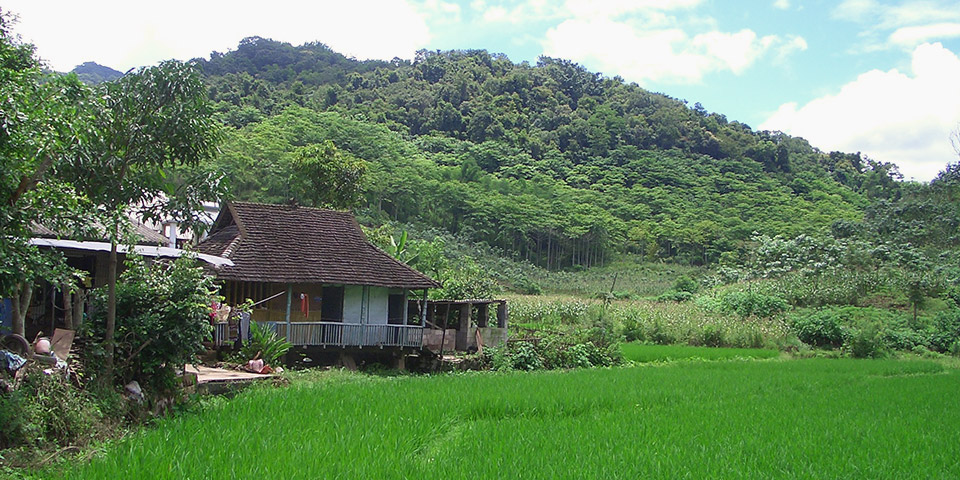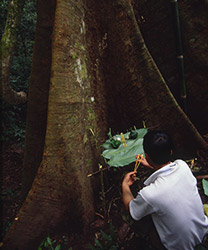Local No lado sur dos outeiros sagrados da provincia de Yunnan atópase a prefectura autónoma de Xishuangbanna Dai., recoñecida como Reserva do Home e da Biosfera da UNESCO. Aínda que cobre menos de 0.2 por cento da superficie total de China, contén uns 20 por cento das especies rexistradas dos países, o que a converte na zona máis rica en biodiversidade do país. Tamén alberga trece dos grupos étnicos de Yunnan, vive principalmente en zonas continentales tropicais e subtropicais. Nos últimos anos, establecéronse reservas para opoñerse ás ameazas que supón o crecemento económico e demográfico.
Ameazas No último 50 anos, 90 por cento do 750 Os bosques de Holy Hill foron destruídos ou degradados. Unha das razóns desta perda é que o rápido desenvolvemento económico e o aumento da poboación provocaron enormes presións no uso do solo, facendo que estes bosques sexan substituídos principalmente por plantacións de caucho. Ademais, a política de ordenación de terras forestais cambiou de xestión comunitaria (1980s) á xestión individual (2000s), que creou a opción para que os aldeáns arrendasen as súas terras forestais individuais a outros.
Se cortas todas as árbores, só tes casca para comer; se destrúes o bosque, destrúes o teu camiño cara ao futuro - Dai Folksong da provincia de Yunnan, China (Wang 1988)
Custodiantes Con preto de 35% da poboación de Xishuangbanna, os dai son o grupo étnico máis abundante da Prefectura. Dependen dos bosques locais para os suplementos alimentarios e o abastecemento de auga. Eles cren que algúns bosques sagrados en Santos Outeiros (Nong) son a residencia dos deuses. As plantas e animais que habitan nestes bosques son os seus compañeiros, xunto cos espíritos dos antepasados falecidos que tras a súa morte se trasladan a estes bosques. A violencia ou a perturbación de plantas e animais nestes bosques será castigada polos deuses e está terminantemente prohibida nalgunhas comunidades.. Ata aproximadamente 50 anos, estes bosques estaban protexidos por institucións tradicionais dirixidas por un home xefe espiritual (Sopa) da aldea local. O Dai seguiu orixinalmente unha tradición animista, que estaba moi ligado ao mundo natural, e tiña unha filosofía orientada ao bosque. Na percepción Dai a interrelación entre os seres humanos e o seu medio físico consta de cinco elementos principais: bosque, auga, terra, alimentación e humanidade. Cren que o bosque é o berce dos humanos. A auga vén dos bosques, a terra nútrese da auga e a comida provén da terra. Así, os bosques soportan a vida humana e estes bosques son un co reino sobrenatural.
Alianza Os xestores das reservas e os custodios locais das aldeas xestionan conxuntamente as reservas mediante enfoques de xestión participativa. Os regulamentos comunitarios sobre o bosque sagrado e as actividades tradicionais de costumes e cultos organízanse e aplícanse segundo o interese dos veciños..
Ferramentas de Conservación Onde sobreviviron ás presións da modernidade, Os sitios naturais sagrados están ben integrados nas culturas locais e nos sistemas de crenzas tradicionais. A corta de árbores está sancionada cunha multa de USD 20-40 por árbore. A maior escala, reservas naturais, as zonas de amortiguamento e os biocorredores son a principal estratexia para a conservación dos sitios de biodiversidade en Yunnan. Os gardas dos sitios naturais sagrados seguen defendendo a inclusión do seu sitio na rede de sitios biolóxicos protexidos pola lexislación..
Visión No futuro, Holy Hills pode ser sacralizado de novo restaurando bosques sagrados degradados. Recoméndase que se inclúan nos corredores forestais entre áreas protexidas en Xishuangbanna. Hai unha necesidade de apoio político para recoñecer o valor social e de conservación dos bosques sagrados. Isto axudaría a establecer normas de protección, como se fixo anteriormente na provincia de Guangdong. No desenvolvemento posterior desta rexión, o uso do coñecemento tradicional pode facilitar en gran medida unha gobernanza respectuosa co medio ambiente.
Acción A pesar da dramática perda de bosques sagrados en Xishuangbanna, a cultura tradicional foi revivida, e continúa nos bosques restantes. As cerimonias de culto realízanse en agosto e novembro de cada ano e participan todos os membros da vila, ofrendas de alimentos, fanse galiñas e porcos. Ademais, tanto os indíxenas locais como os partidarios externos defenderon o establecemento de reservas naturais na zona.
Política e Dereito Os lugares naturais sagrados non están recoñecidos pola lei. Se algo, os cambios lexislativos facilitaron a súa degradación nos últimos decenios. Con todo, xa que moitas veces albergan unha serie de especies protexidas, hai potencial para que sexan recoñecidos como focos de biodiversidade. Isto realmente está a suceder.
Resultados Segundo entrevistas a xente de catro aldeas da reserva, ningún caso de tala de árbores, no pasado sábese que a caza ou a sobreexplotación se producían na zona do bosque sagrado 20 anos. Isto demostra que a participación comunitaria na xestión do bosque sagrado na reserva é efectiva e exitosa. O establecemento de certas reservas foi un paso importante para a conservación do sitio natural sagrado en Yunnin, pero segue a ser desexable unha maior protección.
- Shengji, P., (2010) O Camiño para o Futuro? Os valores Biocultural dos bosques santo monte provincia Yunan, China, en Verschuuren, Salvaxe, McNeely, Oviedo (2010) Sacred Sitios Natural: Conservación da natureza e da Cultura, Terra de dixitalización, Londres.
- Pei S.J., 2006: Biodiversidade nos bosques sagrados da reserva da biosfera de Xishuangbanna, China, Publicado en ‘UNESCO 2006 (Le e Schaaf). Actas do Simposio de Tokio: Conservar a diversidade cultural e biolóxica, O papel dos sitios naturais sagrados e das paisaxes culturais, UNESCO, París.
- Pei S.J. 1993: Xestión da diversidade biolóxica en Temple Yards e Holy Hills: As prácticas tradicionais da comunidade Xishuangbannan Dai, Suroeste de China, en Hamilton, L.S. (e.) Ética, Relixión e Biodiversidade,, The White Horse Press. Cambridge Reino Unido.
- O Centro de Biodiversidade e Coñecemento Indíxena (CBIK) en www.cbik.org
- Zeng, L. (2012) Transformación cultural e sustentabilidade ecolóxica entre o pobo dai en Xishuangbanna, dispoñible a partir de: www.sustainablechina.info





